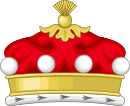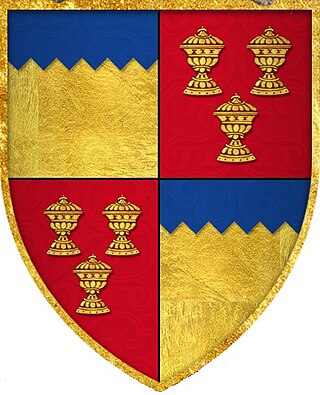
Piers Butler, 8th Earl of Ormond, 1st Earl of Ossory also known as Red Piers, was from the Polestown branch of the Butler family of Ireland. In the succession crisis at the death of Thomas Butler, 7th Earl of Ormond he succeeded to the earldom as heir male, but lost the title in 1528 to Thomas Boleyn. He regained it after Boleyn's death in 1538.
John Butler, 17th Earl of Ormonde, 10th Earl of Ossory (1740–1795) was an Irish peer and Member of Parliament (MP). He became a Protestant in 1764. He was an Irish MP, representing Gowran between 1776 and 1783, and Kilkenny City between 1783 and 1792. In 1791, his right to the peerage was acknowledged in the Irish House of Lords and he became the 17th Earl of Ormond.
Walter Butler (1703–1783), also known as Walter Butler of Kilcash, and Walter Butler of Garryricken, was the de jure16th Earl of Ormond and 9th Earl of Ossory. He did not assume these titles, as he thought them forfeit as a result of the attainder of the 2nd Duke of Ormonde. In the peerage of Ireland, the titles were successfully claimed in 1791 by his son John, the 17th Earl.

Lieutenant-General Charles Butler, 1st Earl of Arran, de jure3rd Duke of Ormonde (1671–1758) was an Anglo-Irish peer. His uncle Richard was the 1st Earl of Arran of the first creation. The titles were re-created for Charles in 1693. His elder brother, the 2nd Duke of Ormonde, was attainted during the Jacobite rising of 1715, but in 1721 Arran was allowed to buy the estate back. At the death of the 2nd Duke, he succeeded as de jure 3rd Duke of Ormonde in the Irish peerage but did not claim the title.
Sir Walter Butler, 11th Earl of Ormond and 4th Earl of Ossory (1559–1633), succeeded his uncle the 10th earl, in 1614. He was called "Walter of the Beads" because he was a devout Catholic, whereas his uncle had been a Protestant. King James I intervened and awarded half of the inheritance to his uncle's Protestant daughter Elizabeth. Ormond contested the King's decision and was for that detained in the Fleet Prison from 1619 until 1625 when he submitted to the King's ruling. He then found a means to reunite the Ormond estate, by marrying his grandson James, who had been raised a Protestant, to Elizabeth's only daughter.
James Butler, 1st Earl of Ormond, was a noble in the Peerage of Ireland. He was born in Arklow, Wicklow, Ireland and died in Gowran, Kilkenny, Ireland.

Earl of Carrick, in the barony of Iffa and Offa East, County Tipperary, is a title in the Peerage of Ireland.
John Butler, 12th Baron Dunboyne was an Irish clergyman and aristocrat, Roman Catholic Bishop of Cork and Ross. In order to advance his temporal title and marry he became, as of 2004, the only authenticated apostate in the Catholic hierarchy in Ireland
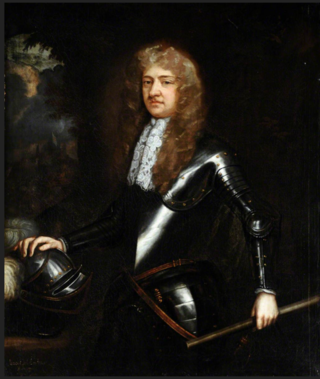
Richard Butler, 1st Earl of Arran (1639–1686) was Lord Deputy of Ireland from 1682 to 1684 while James Butler, 1st Duke of Ormonde, his father, the Lord Lieutenant, was absent in England. He sat in the Irish House of Lords as Earl of Arran and in the English one as Baron Butler of Weston. When William Howard, 1st Viscount Stafford was accused of treason during the Popish Plot, Arran braved the anti-Catholic hysteria and voted not guilty.
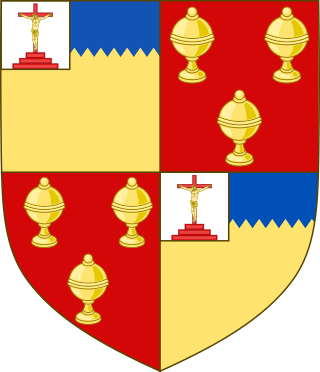
Sir Theobald Butler, 1st Baron Cahir, Caher, or Cahier was the first baron Cahir of the second creation, which occurred in 1583.
Thomas Butler, 2nd Baron Cahir was an Anglo-Irish peer. He was the son of Theobald Butler, 1st Baron Cahir and Mary Cusack. He succeeded to the title on 28 April 1596.

Earl of Glengall was a title in the Peerage of Ireland that was created in 1816 for Richard Butler, 10th Baron Cahir. The subsidiary title of Baron Cahir in the Peerage of Ireland was first created in 1542 for Thomas Butler, who was a descendant of The 3rd Earl of Ormond. James "Gallda" Butler was the son of the 3rd Earl and Catherine FitzGerald of Desmond. "Gallda" Butler married a daughter of MacWalter and together they had one son, Piers (1425-1464). The title was re-created in 1583 with the unusual remainder to heirs general of the first baron, which made his great-nephews, Theobald Butler and Thomas Prendergast, co-heirs. Prendergast ceded the title to Theobald Butler, preferring that the title should follow the strict male line.
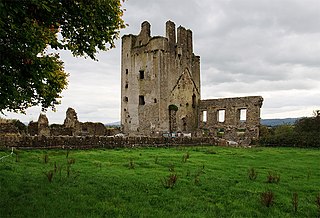
John Butler of Kilcash was an Irish landowner and soldier. A younger son of James Butler, 9th Earl of Ormond and brother of Thomas Butler, 10th Earl of Ormond, he received Kilcash Castle as appanage. He fought in the Desmond–Ormond conflict and was badly wounded in 1563, just before the Battle of Affane. He was the start-point of the Kilcash branch of the Ormonds and the father of Walter Butler, 11th Earl of Ormond.
Thomas Butler, Viscount Thurles was the son and heir apparent of Walter Butler, 11th Earl of Ormond (1559–1633), whom he predeceased. He lived at the Westgate Castle in Thurles, County Tipperary. He was the father of the Irish statesman and Royalist commander James Butler, 1st Duke of Ormonde.
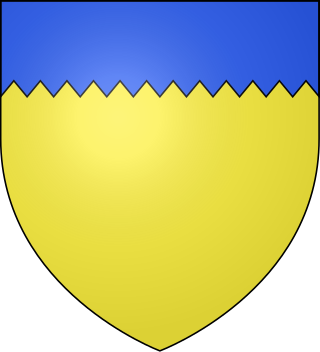
Butler is the name of a noble family whose members were, for several centuries, prominent in the administration of the Lordship of Ireland and the Kingdom of Ireland. They rose to their highest prominence as Dukes of Ormonde. The family has produced multiple titles such as Baron Cahir, Baron Dunboyne, Viscount Ikerrin, Viscount Galmoye, Viscount Mountgarret, Viscount Thurles, Earl of Carrick, Earl of Kilkenny, Earl of Ormond, Earl of Ossory, Marquess of Ormonde and Duke of Ormonde. Variant spellings of the name include le Boteler and le Botiller. The Butlers were descendants of Anglo-Norman lords who participated in the Norman invasion of Ireland in the 12th century. The surname has its origins in the hereditary office of "Butler (cup-bearer) of Ireland", originating with Theobald Walter, 1st Chief Butler of Ireland. The arms of later family members depicted three cups in recognition of their original office.
Richard Butler of Kilcash (1615–1701) was an Irish soldier and landowner, the third son of Thomas Butler, Viscount Thurles and brother of James, 1st Duke of Ormonde. He sided with the Irish Confederacy at the Irish Rebellion of 1641. He scouted the enemy on the morning of the Battle of Cloughleagh. His descendants succeeded to the earldom of Ormond when the senior branch of the family failed in 1758.
Thomas Butler, 1st Baron Dunboyne was the third son of Theobald Butler, 4th Chief Butler of Ireland and Joan FitzJohn.
Edmond Butler, 3rd/13th Baron Dunboyne (1595–1640) was an Anglo-Irish nobleman of the early seventeenth century. His short life was full of violence and disputes over the Dunboyne inheritance. His father was murdered when Edmond was a small child, and Edmond as an adult was forced to defend a lengthy lawsuit brought by his uncle, who sought to disinherit him. In 1627 he killed his cousin James Prendergast in a quarrel over a disputed inheritance. For this crime, he was tried by his peers for manslaughter, but was acquitted.
Theobald Butler, 1st Viscount Butler of Tulleophelim, was an Irish peer.
Theobald Fitzwalter Butler, 14th Baron Dunboyne was an Irish peer.
